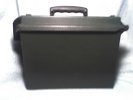|
Have been trying to plan out some possible scenarios for deploying a HSMM-MESH network here in central Illinois. Even though we have no operational nodes in our city, I have been talking with a few HAM's that have expressed interest in getting something started. Our cities population is about 116,000 and when you take into account some of the "burbs" would put this over 125K. Our coverage area would be about 8 miles total distance from the center of the city. There are many multi-story buildings in the downtown area that would create a lot of problems getting signals in and around. My biggest concern is getting signals to some pre-determined out of town nodes. I currently have a HAM who has a 100' tower (in a rural setting surrounded by cornfields) and I am able to put a node at approximately 45'. Using the "Heywhatsthatmap" profile planner it appears on paper that the terrain and signal should be sufficient. Looking at it with an "eyes on the ground" (or in the air if you will) perspective there are a considerable amount of trees at 60' or better near my location in the city. The distance between the two nodes would be 13 miles. When using the online terrain calculators it looks OK, but I have had some other people tell me that if even 1 tree gets in the way the signal is done. I've seen online where people say they have achieved great distances, but it appears those locales were very flat with minimal vegitation or from mountain top to mountain top. I have yet another questions about distances and I know that there will be so many variables that the answer would be an educated guess. However, If someone had an an Omnidirectional antenna 45' up and another person had a mobile set up with a mag mount antenna atop a vehicle, in an urban setting, what kind of distance could be realistically expected. I've heard some people say that you'd be lucky to go three city blocks. I'm still in the learning phase of this so please excuse my lack of knowledge.
Thanks & 73's Jess
I've attached a copy of the Hey What's That Path Profile image to use as a reference. Could someone give me their thoughts on whether this hop would work or not.
|
